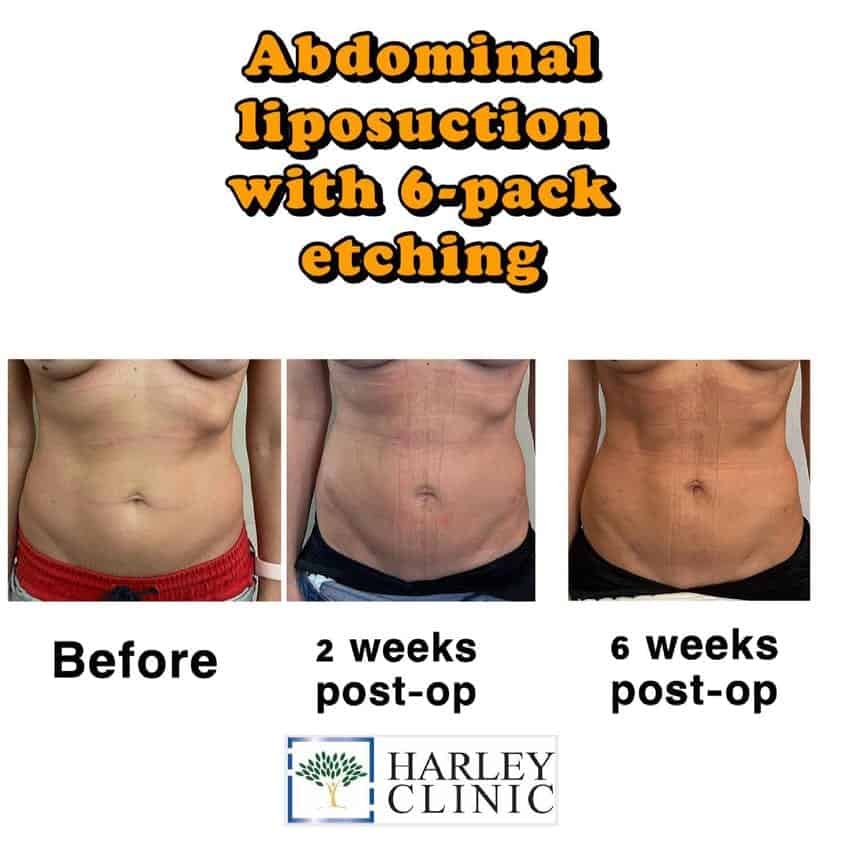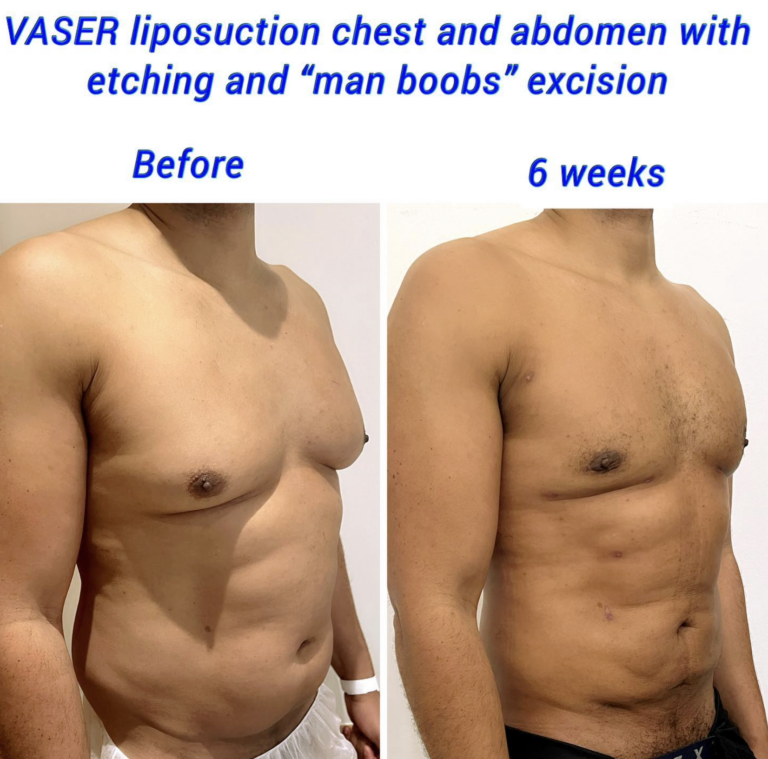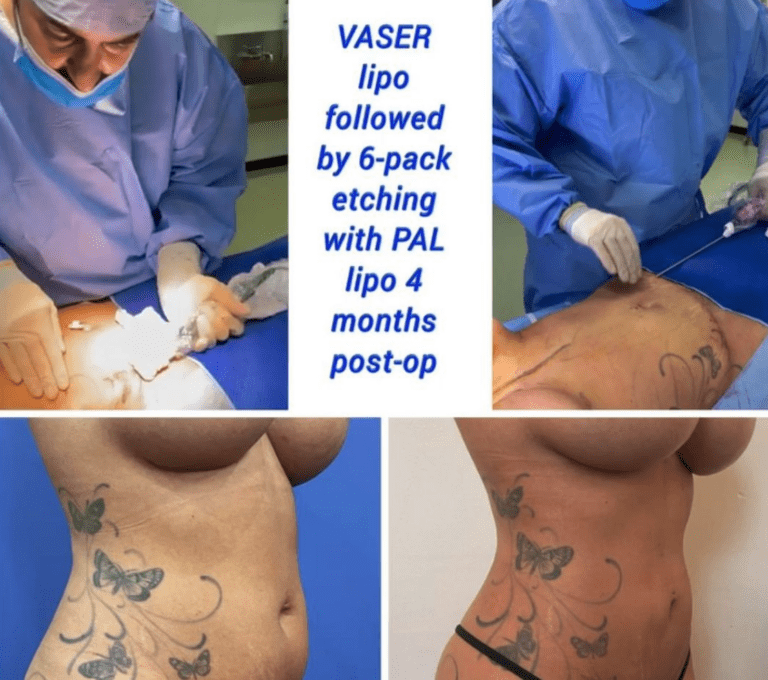Abdominal etching is a type of liposuction procedure to remove fat that allows your natural abs to protrude through creating the appearance of a six-pack.
What is Abdominal Etching?
Abdominal etching is also known as liposuction for abs for patients who want to achieve a washboard stomach. The procedure creates a more defined six-pack. In most cases, it’s a very safe and effective surgery.
If you have a stubborn layer of fat that you’re struggling to get rid of, abdominal etching may benefit you. It’s a type of liposuction that removes stomach fat. The ideal candidate for this surgery is at a healthy weight, eats well, and has stubborn stomach fat but already has underlying tone in the abs.
Abdominal Etching: Quick Overview
- Surgery Time: 1-2 hours
- Anaesthetic: General
- Hospital Stay: Day
- Dressings and Garments: Wear compression garment for 2 weeks
- Time Off Work: 1 weeks
- Exercise: 3-4 Weeks
- Mobile: 1 day
- Washing: 1 day
- Sleeping Position: on you back, elevated with a bend for 2 weeks
- Full Recovery: 6 weeks


What Happens During Abdominal Etching Surgery?
Abdominal etching surgery takes between 1 to 2 hours to complete. It’s a minimally invasive form of liposuction. Before your procedure, your surgeon will outline your abdominal muscles with markers. These help to guide the surgery. When you are fully happy with your markings, you will be put under general anaesthetic.
During the procedure, your surgeon uses small cannulas to remove pockets of fat from the abdomen and tightens the skin. It’s similar to traditional liposuction, but with a complete focus on the stomach and removing that layer of fat that covers your natural abs.
After the surgery, the incisions are closed with a protective dressing. Because the cannulas are so small, the actual incisions don’t need sutures. So, you don’t have to worry about removing sutures at a later date.
What are the Benefits of Abdominal Etching?
Abdominal etching is a popular treatment among men and women. The procedure is not considered a weight-loss tool. Patients should already be at a good weight before the surgery to achieve the best results. Benefits of abdominal etching include:
- Defined six-pack
- Natural-looking
- Washboard abs
- Boost confidence
- Minimal scarring
- Long-lasting results
How Long Does it Take to Recover From Abdominal Etching Surgery?
Immediately following your surgery, you will need to wear a compression garment. This helps to reduce swelling and ease your recovery. You will wear a compression garment for the first 2 weeks.
In general, you will need about 1 week off work to recover. You will experience mild discomfort initially. Your surgeon will give you directions on managing any pain and how to use your compression garment. During this time, you should avoid any exercise while you recover. You should start to see results after about 6 weeks. The final result should appear in 3-6 months. You can usually resume normal activities and exercise in 3-4 weeks.
What Happens During Your Abdominal Etching Consultation?
During your consultation, you will discuss your concerns with your stomach, medical history and current medications. Your surgeon will take photos, discuss the procedure, and determine if you are suitable for the surgery.
Who is a Suitable Candidate for Abdominal Etching?
You are a suitable candidate for abdominal etching if you have a healthy diet and exercise regularly. You should be at a healthy weight with no more than 20% body fat. You have some resistant tummy fat but have an underlying tone in your abdomen muscles. If you have previously undergone tummy tuck surgery or liposuction, you can usually go head with abdomen etching to achieve a more chisilled appearance.
How to Prepare for Abdominal Etching
Before your surgery, you should stop smoking and taking certain medications. Follow a healthy diet and be as healthy as possible to prepare for abdominal etching.
What to Expect After Surgery
After the procedure, you should expect some swelling and bruising, which can be managed by painkillers. You should be able to shower one day after your procedure.
When Will You See the Final Result?
You can see the results immediately, but the final result can be seen between 6 and 12 months.
Are the Results Permanent?
Abdominal etching is considered permanent because it’s unlikely that the fat cells in the abdomen will be replaced. However, you need to maintain a healthy weight and exercise regularly to retain your abdominal etching results.
What are the Scars Like Following the Surgery?
Lipo etching uses small cannula tubes; therefore, it will only need small incisions. The incisions are strategically placed, so even if you have some scarring, it will be well-hidden.
What is the Difference Between Liposuction and Abdominal Etching?
The main difference between the two procedures is that liposuction removes fat from multiple problem areas of the body. Whereas abdominal etching removes localised fat from the abdomen with the sole purpose of creating a more defined abdomen.
Is Abdominal Etching Painful?
After your surgery, you may feel a little sore. Any discomfort should subside in about 3-4 days. In a couple of weeks, your body will feel much more back to normal.
Can You Combine Abdominal Etching With Other Procedures?
Abdominal etching can be performed as a standalone procedure or combined with other procedures, such as:
- Mini tummy tuck
- Body contouring procedures
- Brazilian butt lift
There are some limitations with combining abdominal etching and a mini tummy tuck. If the stomach muscles are too loose, there may be some limits with what can be achieved through a mini tummy tuck.
Before and After Abdominal Etching at the Harley Clinic

Is Abdominal Etching Safe?
Abdominal etching is considered a safe procedure when done by an experienced and qualified plastic surgeon. Your surgeon has expert knowledge of human anatomy and liposuction techniques to achieve maximum results.
What are the Potential Risks and Complications of Abdominal Etching?
There are potential risks and compilation with any surgery. With this type of treatment, you must attend any follow-up appointments after your procedure. This is key for spotting any fluid build-up to treat seromas if they occur. Other potential risks and complications include:
- Infection
- Bleeding
- Hematoma
- Anaesthesia risks
- Skin and or fat/necrosis
- Fluid accumulation
- Pain
- Swelling
- Poor wound healing
- Poor scarring
- Nerve injury
- Contour irregularity
- Seroma
- Over/under correction
- Asymmetry
- Damage to other structures
- DVT
- PE
- Chest infection
To book a consultation today, please call 0203 582 4947 or email [email protected].
Further Reading:
- 8 Things to Know if You’re Considering Liposuction
- 7 of the Most Common Areas for Liposuction
- What is Lipoedema? Signs, Symptoms, Causes, and Treatment
- 8 Top Body Contouring Surgeries
- Simple Aftercare: 5 Tummy Tuck Recovery Tips
- Tummy Tuck for Men: Here’s What to Expect
- Mini Tummy Tuck Recovery: Here’s What to Expect
- Does a Tummy Tuck Scar Fade? (+ 7 Simple Recovery Tips)










